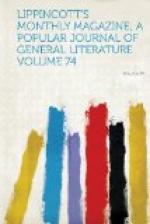In the Doctor, Energy was stored in bond as it were, subject to duties, and only to be issued on certificate that it was wanted for use and everything ready for it: therefore at the Professor’s “Come on” he calmly sat down on a log, filled his pipe, leisurely lighted it, and good-humoredly remarked, “I am confident that one-half of what we call life is spent in undoing what we have done, in lamenting the lack of what we have forgotten, or going back after it: therefore I make it a rule when everything seems ready for a start—especially when going fishing—to sit five minutes in calm communion with my pipe, thinking matters over. It insures against much discomfort from treacherous memories and neglect.”
As the Doctor whiffed at his pipe, he inventoried guns, tackle, lunch, hammocks, air-cushions, gigs, frog-spears, and all other necessaries for a day’s sport on the river. The result was as he had prophesied,—many things had been omitted. “Now,” said he, when the five minutes were up, “we might venture down the bank, which, rest assured, each member of this party will have to climb up again after something left behind.”
A motley little fleet awaited the party at the water’s edge,—square-ended, flat-bottomed punts, sharp-bowed bateaux, long, graceful, dug-out canoes, and a commodious push-boat, with cabin and awning, whose motive power was poles. Elk River craft are as abundant as the log cabins on its banks, and their pilots are as numerous as the inhabitants. Neither sex nor size is a disqualification, for, excepting the trifling matter of being web-toed, all are provided from birth with water-going properties, and, be it seed-time or harvest, the river has the first claim upon them for all its varied sports and occupations. A shot at mallard, black-head, butter-duck, loon, wild goose, or blue-winged teal, as they follow the river’s winds northward in the spring-time, will stop the ploughs furrowing its fertile bottoms as far as its echoes roll around mountain-juts, and cause the hands that held the lines to grasp old-fashioned rifles for a chance at the winged passers. When, later, woodcock seek its margins, gray snipe, kill-deer, mud-hens, and plovers its narrow fens, the scythe will rest in the half-mown field while its wielder “takes a crack at ’em.” And when autumn brings thousands of gray squirrels, flocks of wild pigeon and water-fowl, to feed on its mast, no household obligation or out-door profit will keep the natives from shooting, morning, noon, and night.




